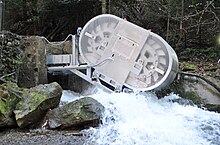Steffturbine
The Steffturbine is a turbine for generating electrical energy from hydropower .
The Steffturbine is suitable for use in small hydropower plants and can be operated in a modular design. A module can be used at heights of fall of 3 to 5 meters and flows of up to 0.5 m³ / s and generates an output of up to 10 kW. The Steffturbine was developed by Walter Reist Holding AG and is sold as a complete system including generator and control electronics. Together with the Steffstep fish ladder and the Steffmaster, it forms the so-called Steffworld.
functionality
The Steffturbine works like an overshot water wheel, since it is essentially driven by the potential energy of the water. It consists of a conveyor chain equipped with profiled blades that runs around two rollers. These are arranged in such a way that the head water drives the conveyor chain on an inclined plane. Different inclinations of the turbine are possible.
The Steffturbine is filled with water through an inlet channel. The blades are loaded by the incoming water. The chain, which is mounted on rollers, is set in motion by the forces acting on the blades. The moving chain then causes the rollers to rotate. A generator is connected to the rotating rollers via a transmission. The generator converts the mechanical power of the rotational movement into electrical power. The voltage obtained is modulated by the power electronics and processed for the various operating modes.
Areas of application
The Steffturbine can be used to feed the grid, in island operation or in self-sufficient networks. The mechanical construction does not differ between the individual operating modes. Only the power electronics have to be equipped with various components. The Steffturbine can be used wherever water flows with a gradient. These include rivers, dams, sewage treatment plants or existing barrages that are to be revitalized. The inclination and length of the Steffturbine are adapted to the respective conditions. In the simplest case, the Steffturbine can also be placed on the surface of the water, where it is then flowed through. Thus, the river's ecosystem remains largely unaffected.
Efficiency
The turbine works most efficiently at slopes of 30 ° to 60 °. The efficiency was examined in the laboratory for the individual development stages of the turbine. For the first prototype it was a maximum of 86%. The optimization possibilities resulting from the investigations were pursued further and led to an improvement of the turbine efficiency to the current 92%.
Web links
Individual evidence
- ↑ a b Malcherek, Kulisch, Maerker: The Steffturbine - a small hydropower plant based on the circulating belt. Water management, 10/2011, 30-33. Vieweg Teubner, Stuttgart, 2011.
- ↑ a b Steffturbine - Linear Power: The world needs renewable energies, company brochure.
- ↑ University of the Federal Armed Forces, Munich, Institute for Water Management: Investigation of the efficiency of a new water turbine ( Memento of the original from November 17, 2015 in the Internet Archive ) Info: The archive link was automatically inserted and not yet checked. Please check the original and archive link according to the instructions and then remove this notice. .


